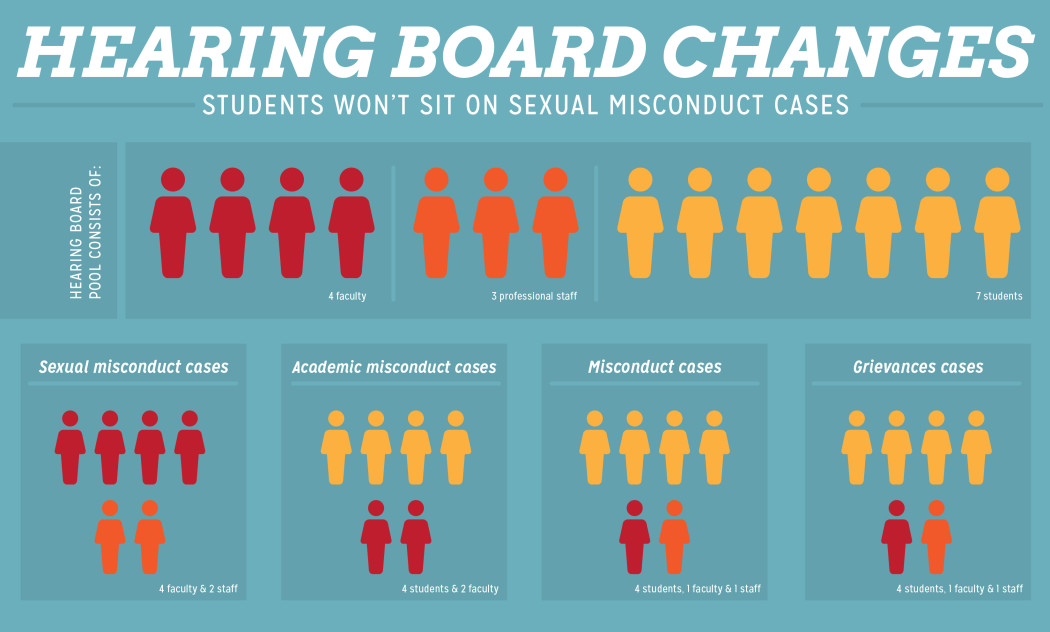Changes made to Student Conduct Hearing Board, sexual misconduct discipline
Changes were recently made to the composition of the Student Conduct Hearing Board in regards to hearings for discipline in sexual misconduct cases.
“In those cases… only faculty and staff will be drawn from the pool to hear a case, with four faculty and two professional staff being seated for a Hearing Board and two faculty and one professional staff being seated for an appeal board,” said Krystin Deschamps, the Student Conduct Coordinator at Utah State University, said in an email to the Statesman.
The changes have been made on an interim basis and happened to better comply with policy guidance from the Department of Education Office of Civil Rights, said Deschamps.
“Once these changes are in place, the university will begin the formal process for making permanent revisions to the sexual harassment and sexual misconduct policies,” Deschamps said. “This process will take much longer but will provide numerous opportunities for students and other members of the campus community to provide input on a variety of issues.”
The Student Conduct Hearing Board is comprised of a pool of seven students who are appointed by the Utah State University Student Association President and confirmed by the other USUSA officers: three professional staff members appointed by James Morales, Vice President for Student Affairs; and four faculty members, appointed and confirmed by the Faculty Senate, Deschamps said.
The hearing board hears cases and appeals that include academic integrity issues, behavioral misconduct and student code of conduct violations, grievances and discipline for sexual misconduct. For each different type of case, different numbers of students, staff and faculty who are on the board are pooled to be involved in the case, Deschamps said.
The Office of Civil Rights (OCR) has issued several policy guidance documents, including the 2014 Questions & Answers on Title IX and and Sexual Assault guidance document, which “provided information about universities’ obligations when conducting hearings in sexual misconduct cases,” Deschamps said. “In that document, OCR ‘discourage[d] schools from allowing students to serve on hearing boards in cases involving allegations of sexual violence.'”
However, there is also the involvement of others besides the hearing board in looking over cases of reported sexual misconduct.
The Affirmative Action/Equal Opportunity/Title IX Coordinator is responsible for “receiving and investigating complaints of sexual harassment regarding students, employees and visitors,” said Stacy Sturgeon, who is the director of Affirmative Action/Equal Opportunity and the Title IX Coordinator at USU.
This step has always been a part of the process; however, two policies — Policy 339 (Sexual Harassment) and Policy 305 (Discrimination Complaints) — have been updated “to more clearly explain how a complaint of alleged conduct of a sexual nature by a student moves from USU Student Code to Policy 339 and Policy 305,” Sturgeon said in an email to the Statesman.
The changes in the last few months with the student code and these two policies have been made to clarify and be more transparent when it comes to notice of process. Notice involves not only posting policies — which USU has done on websites and in trainings — but also making sure the changes are clear and complete for anybody to understand, Sturgeon said.
There has also been information about where and how to report sexual harassment — including sexual misconduct — along with “references to the Title IX Coordinator, updated examples and definitions and Utah State University’s commitment to eliminate harassment, prevent its recurrence and correct the discriminatory/harassment effects,” Sturgeon said.
The investigative timeline has also been changed from 35 days to 60 days, to be more in line with policy guidance from the OCR, along with opportunity for the complainant of a misconduct and the respondent to provide responses to the investigative report before it is final, she said.
When evidence indicates that policy and the code has been violated, there have been updates made to clearly state how the complaint/investigative process moves from Policy 339 and Policy 305 to the USU student code and the hearing board, Sturgeon said.
“It is plainly defined that for students, the Vice President for Student Affairs or the Vice President’s designee will impose sanctions, if warranted, by following the procedures set forth in the University Standards of Student Conduct,” she said.
Though students on the hearing board are no longer involved in those cases involving discipline for sexual misconduct, they will continue to be a part of all other cases.
“To be a student on the hearing board, to see how the school works in this process of upholding student conduct, it really makes me grateful that there are people that are doing this stuff,” said Chris Glaittli, one of the students who has been on the hearing board for the last year.
Glaittli, a senior majoring in public relations, believes that most students don’t know just how amazing the people involved with the hearing board and student conduct are.
From faculty to staff to police officers on campus, “not only is there a very heavy hit on making campus safe, but there is a passion from them. They truly do care about the safety of each and every student,” Glaittli said. “There has to be protection at school and everyone should feel that way. There are people behind it that are just amazing and doing a lot.”
For more information about the Student Code of Conduct, the Student Hearing Board and other related topics at USU, visit: studentconduct.usu.edu.
— mandy.m.morgan@aggiemail.usu.edu

